1998 Porsche 911 GT1 ’98 – Ultimate Guide
1998 Le Mans 24-hour race, the Porsche team celebrated its 16th overall victory in Le Mans with a double win for the 911 GT1 98. On 6th/7th June, the winning car was driven by Laurent Aiello, Allan McNish and Stéphane Ortelli. It was almost 50 years to the day on which the first Porsche sports car saw the light of day.
The 1990s were not good for Porsche when it came to Le Mans success, but in 1998, things turned around with the 911 GT1 98 able to get Porsche back to its winning ways. The 15th Le Mans win came in 1994 with the Dauer 962 (Porsche engineers discover that the 962 C could be modernized and modified to be eligible as a Le Mans GT1 race car, because the required street-legal version already exists: the Dauer 962). It was an awesome race car but it was getting on in age and was no longer competitive enough for an outright win.
That is when Porsche decided on an entirely new, 911-derived design — the Porsche GT1. Porsche knew that it needed something fresh to remain competitive, and that its new racer needed to look like the 911, so with Norbert Singer at the helm the company set to work on the GT1 to compete in the BPR GT Series. The original design basically took the entire front section of the 993 but with the body being a totally new and custom steel section connected on to carry the engine and transmission that had been turned through 180 degrees and mid-mounted.
The 1996 911 GT1 had a 2nd and 3rd place at the 1996 Le Mans. Several updates (it got 996 derived headlights and other mechanical changes) were made for the 1997 911 GT1 (it was known as the 1997 Porsche 911 GT1 Evolution). There was no finish at Le Mans in 1997.
Porsche’s resolve was still strong and thanks to race team boss Herbert Ampferer convincing engineering director at the time Horst Marchart to continue development on the GT1, Porsche ended up being quite drastic in their approach. They opted for a clean-sheet design that shared almost no parts with the road cars. There was little pretence of remaining close to the production 911, Porsche was going to build a straight-up Le Mans prototype (FIA regulations required just one ‘Strals’enversion‘ road model to be built).
The GT1 marked a number of firsts for Porsche, one of which was the use of a carbon-fiber monocoque chassis, with the sections and panels constructed by English specialists, CTS. Talented engineer Horst Reitter had designed the carbon tub and he had plenty of experience, having also been responsible for Porsche’s first racing monocoque for the Porsche 956. The design was 100% CAD driven (for the first time). A quarter-scale model was tested in the wind tunnel, with the data transferred to CAD computers for production of the final car. The final car was checked a second time in Weissach‘s wind tunnel, many further hours being devoted to honing the final shape.
The proliferation of slats and vents that adorned the bodywork was testament to the amount of time spent perfecting the aero and cooling of the ‘98 GT1. A further crucial difference compared to earlier GT1 incarnations was around the weight of the car. Herbert Ampferer had gone on the record saying he wanted the car to be 10% lighter than the ‘97 GT1. The diet and new-car from the ground up approach worked because the ‘98 GT1 weighed only 2,072 lbs (the 1997 GT1 weighed 2,337 lbs).
The carbon-fiber not only helped the car weigh less but it was also a lot stiffer which is important in all race cars when it comes to handling. The new car was also slightly longer and wider and also sat a little lower too. The wheelbase had also grown. There was also a large, adjustable plastic rear wing, while the nose was noticeably lower, a development achieved by relocating the cooling radiators from the centre to the outer edges of the front end. It even got cool supercar hinged doors for the first time.
The engine was largely the same as the previous GT1s. A water-cooled, 3.2 liter flat six unit adapted from the 962 race car, but fitted with one-piece aluminum cylinder heads from the Porsche 959. The block was also in aluminum, and four valves per cylinder were operated by chain-driven camshafts. While the original 74 mm stroke was retained, the bore was enlarged from 95 mm to 95.5 mm for a 3,198cc capacity. Also retained were the pair of KKK K27.2 turbochargers fed by a massive scoop on the roof and blowing through twin intercoolers, along with a TAG 3.8 engine management system that controlled multi-point sequential injection and cylinder-selective knock control.
The result was around 550 hp at 7,200 rpm and 465 lb/ft of torque at 5,000 rpm. The transmission was upgraded with the dog-clutch six-speed changing for a conventional shift pattern for a sequential arrangement more suited to endurance racing. It had an additional pump for improved lubrication, an oil to-water heat exchanger, and a new triple-disc carbon clutch.
Other notable improvements were the front suspension, where an entirely different set-up was installed and gave Porsche race engineers a lot more wiggle room in terms of setting changes and tuning. Double wishbones, pushrods and transverse coil springs with Bilstein dampers were also part of the ‘98 GT1 set up. The same suspension arrangement was employed at the rear — there was an anti-roll bar at both ends. The car handled better as a result but perhaps even more important was that this set up necessitated the move of the 100 liter safety cell for fuel to a position between the bulkhead and engine, which was a vast improvement when it came to weight distribution. Hydraulically assisted steering also featured, while the Michelin tires 27/67—19 front and 31/70-19 rear — sat on ll.5×19 inch front and 13×19 inch rear single—piece BBS rims.
The ’98 GT1 & The 1998 Le Mans – The Full Story
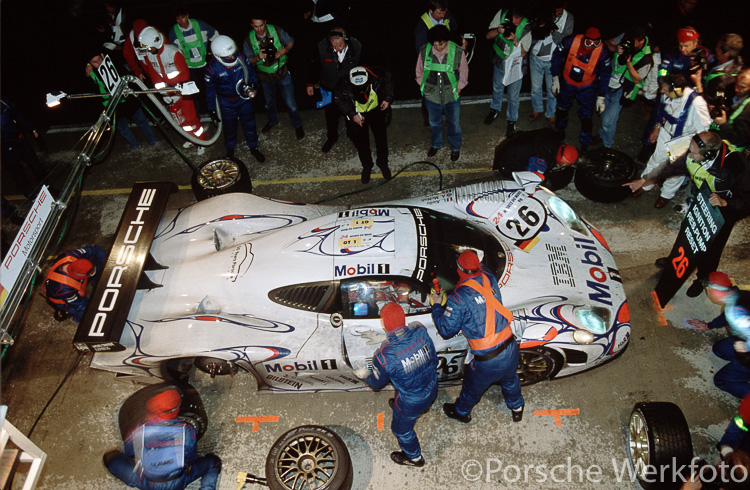
The Porsche 911 GT1/98 Le Mans winning car had its origins in a roadgoing version of the Group C 962, the Dauer 962 Le Mans GT. To trace the timeline of this successful race car, it is necessary to go back to 1993 when Norbert Singer attended the Frankfurt Motor Show (IAA). At the IAA, Singer saw the Dauer 962 Le Mans GT road car that racer/constructor Jochen Dauer had prepared, and Singer’s very active mind saw in this model, a potential new race car that would satisfy the 1994 Le Mans regulations.
Background
Jochen Dauer Racing was formed in 1987, and Dauer enjoyed several years of racing with the Porsche 962C in the German Supercup and European Interserie championships, with occasional entries in other international championships too. Dauer was himself a fairly successful driver, winning the 1988 Interserie Teams’ and Drivers’ Championships. Once he had ceased his racing activities, however, he turned his attention to creating a series of street legal supercars using the 962 chassis, the first of which was presented at the 1993 IAA.
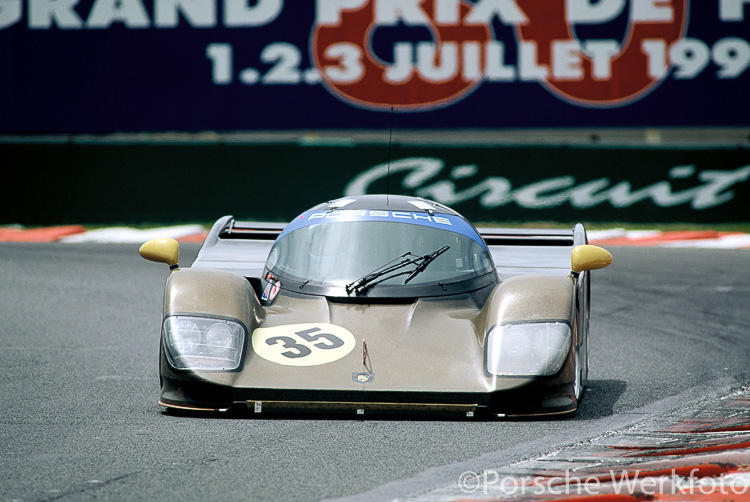
1994 Dauer 962 GT LM
Porsche did not have a race car with which they could win Le Mans outright at that time, the only race car the company had was the 911 Carrera RSR 3.8 which was of course a GT contender. Norbert Singer’s approach could not have been better timed as Dauer was finding it somewhat hard going financially in his efforts to create a series of 962 road cars. A plan was thus set in motion that allowed Dauer to complete the IAA show car and get it road registered, and the extra chassis and spares that he had were returned to Porsche in settlement. Porsche needed to have the one street legal model for Singer’s plan to succeed which would use the Dauer 962 Le Mans GT road car as the basis for his next (1994) Le Mans campaign. Norbert Singer, “It was clear with all the experience we had with the 911, that the rear-engine position is very good on traction and a little bit on braking, but that was it.” Driving the #36 3-litre Dauer 962 Le Mans, Yannick Dalmas/Hurley Haywood/Mauro Baldi, won the 1994 Le Mans 24 Hours for Porsche, confirming that Norbert Singer’s concept was a good one.
GT1/96 and GT1/97
Following the demise of the Group C era, the organisers of the Le Mans 24 Hour race, the Automobile Club de l’Ouest (ACO), shifted their focus away from the prototype era of the ‘80s and early ‘90s, and more towards GT cars. “The Le Mans people didn’t really like the Dauer car, but it was to the letter of the regulations, and out of this we developed the GT1 car. The idea was to have it as close to the road car as possible, and so for the 1996 and 1997 seasons we took the steel body shell of the 911 and cut it just behind the driver seat. We then made up a frame which we attached to the back of this, and by turning the engine and gearbox around, we had a mid-engined car,” Norbert Singer revealed with a smile.

The records will show that the 911 GT1/96 finished second and third at the 1996 Le Mans, while the following year, the two factory GT1/97s posted a NRF and a DNF. While the ‘96 and ‘97 models showed potential, they were too heavy and not aerodynamically optimised.
GT1/98 design brief
The GT1/96 used a 993-production shell, cut behind the driver’s seat, where a firewall was installed before a frame was attached to carry the engine, gearbox and suspension. Many parts from the production car were used, such as the 5-dial dashboard, and the race car was even fitted with a 964 Speedster windscreen. Tony Hatter, the GT1’s designer commented, “It was recognised that the ‘96 car had some deficits in the aerodynamics department and that is what we had to address. The track was increased on the ‘96 car so we had to add wheel arch lips shortly before it went to race. That meant we didn’t really have very clean fenders at all, it wasn’t properly resolved from an aerodynamic standpoint, so we had to go back and rethink it. It had to be as aerodynamically efficient as possible because we knew we had to win Le Mans. Basically, the GT1/98 was the beginning of a modern LMP1 car.”
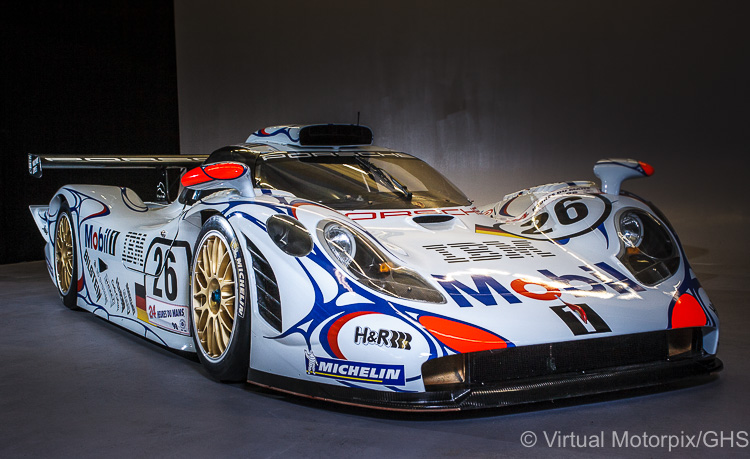
With the introduction of the new 996 model, the GT1/97 had to take on the look of the 996 in the same way that the GT1/96 had resembled the 993 model. Hatter again, “The nose got bigger air intakes and then, because we were now going into the next model of 911, we put 996 headlights on the front on a 993-based GT1 car. It was all a bit surreal.”
Unfortunately, neither the ‘96 nor the ‘97 model produced the desired results at the 24 Hours of Le Mans, and so the racer had to undergo a significant rethink. Norbert Singer expands, “Moving on to 1998, because we wanted to have a lighter car, it was clear that we had to abandon the steel chassis, so we made a kind of 911 with a carbon chassis which was actually a prototype. The Board said it had to look like a 911, but it was not easy to get the face of the 911 on a prototype car.”
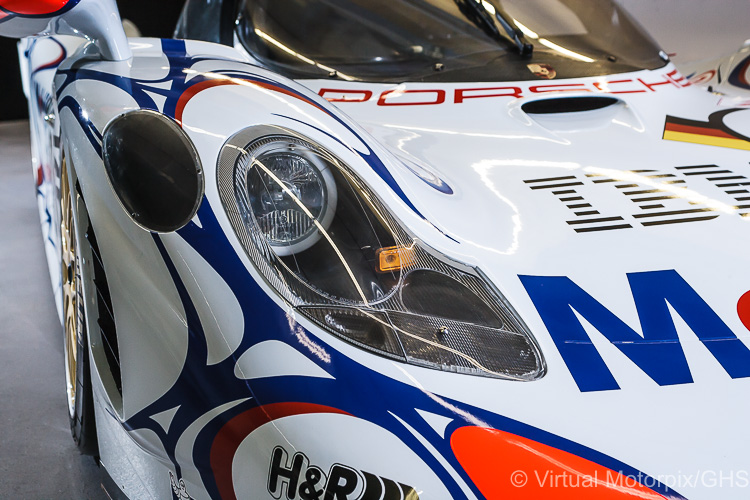
The GT1/98 was the product of state-of-the-art computer aided design software and a modern approach to modelling. Unlike its predecessor, Porsche did not build a full-size model of the GT1/98. Instead, a team of professional digital modellers was brought into the studio and the car was modelled entirely on the computer in parallel with a scale model for wind tunnel testing.
“In a normal design process, we would have to reach various milestones at which point things would have to be feasible,” explained Tony Hatter. “We tried to have a very rigid design schedule, but this project had a different character because it was a very tight and intense process which was condensed into just a few months. So there just wasn’t time to do a proper styling freeze as we had to make decisions basically as we went along.”

Body & Aero
“The greenhouse [of the ’98 car] was much narrower compared to the ‘96 and ‘97 cars,” Harm Lagaaij pointed out. As a result of the body width remaining the same, and the width of the greenhouse being narrower, this meant that the horizontal distance between the side window and the sides of the car that ran from the front to the rear wheel arches, became wider. Harm Lagaaij again, “The door section of the 1996 and 1997 car was very similar to the 911, whereas on the 1998 car it was a completely different story. The doors are hinged on the A-pillar, and they moved forwards and upwards in one movement.”

Where the ‘96 and ‘97 models were fitted with a 964 Speedster production windscreen, the GT1/98 car was fitted with a bespoke, almost wraparound windscreen. The sweeping body panels were fabricated by CTS, a subsidiary of Lola Cars in Huntingdon, England, and then shipped over to the motorsport department in Flacht. Norbert Singer, “The body panels were made by CTS in England, which was previously the composite shop at Lola Cars. They split this department from Lola in order to attract more customers.”
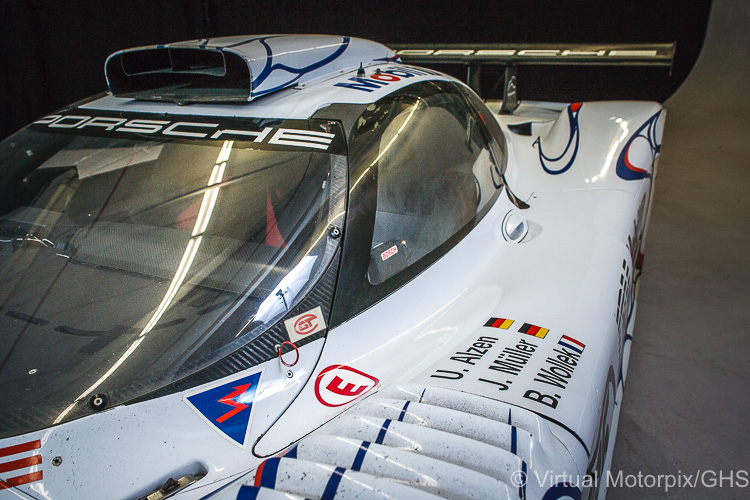
Just ahead of the windscreen, the small, centrally-positioned air scoop was to direct cool air into the cabin, while the finned section just behind the doors is for air extraction from the cockpit.
The undercar airflow was as crucial to the overall efficient aerodynamic package, as the airflow over the car was. Lagaaij explains, “Obviously, the diffuser was much more efficient than on the ‘96 and ‘97 cars, because it was longer and steeper.” With the whole front end being new, the front splitter too was quite different and worked efficiently with the rear diffuser and wing.
Dimensionally, the GT1/98 differed from its predecessor in a number of ways. The wheel base was lengthened from 2500mm to 2690mm, the height was lowered by 33mm to 1140mm, the overall length increased by 215mm, and the width was increased by 10mm.
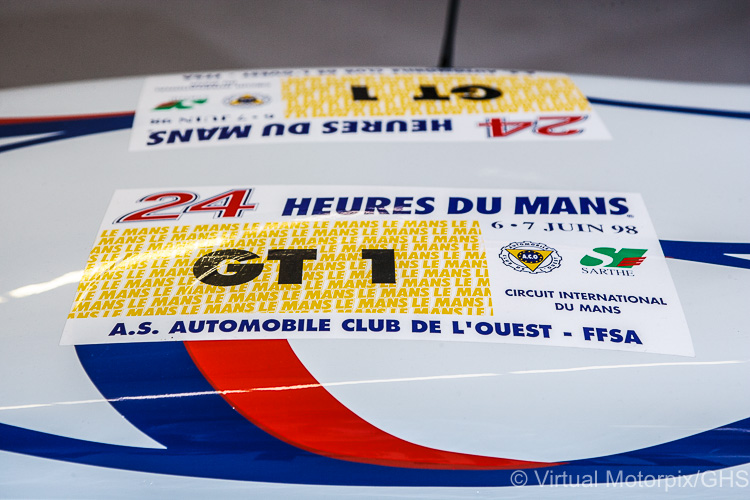
A totally different cooling system on the GT1/98 resulted in a lower profile in the centre of the nose, as the centrally located radiators were moved to either side and positioned in the wheel arches, with the outlets just ahead of the front wheels. The fenders were free as far as the regulations were concerned, so these could be redesigned for the ’98 model after the earlier ones were considered not to have had a ‘clean’ finish. It was, though, necessary to fit the 996 headlights, but as Harm Lagaaij explained, “The angle on the front fenders is totally different, compared to the 996 road car. You had to implant the headlamp into the shape of the front fender on the race car, and the position of the headlamp internals are of course at a different angle.”
The exterior wing mirrors had to meet road car regulations, as the race car had to be the same as the single street version required for homologation. Tony Hatter explains, “When you are designing an outside mirror, the driver had to have a line of sight over the huge rear fenders and wing. There is a certain area that the mirror has to reflect from the rear of the car, so that is why the mirror ended up being so big, because it had to be made street legal. Actually, the mirror housing is one of the only things carried over from ‘96/97 car.”
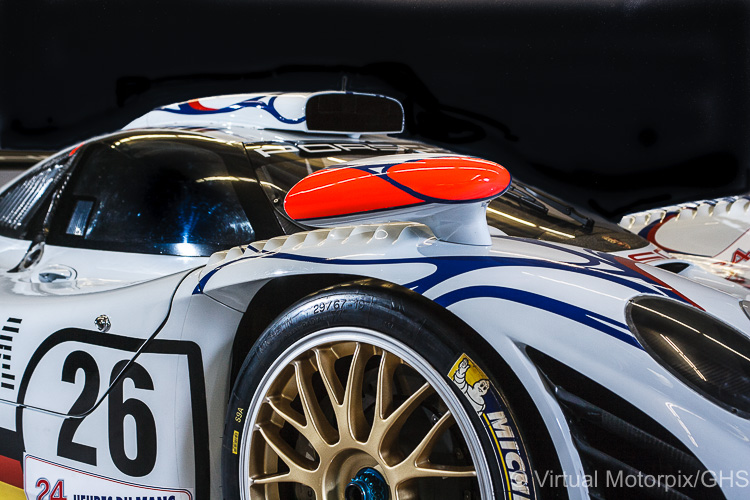
The GT1 was produced during a three-year period, between 1996-1998, as Harm Lagaaij outlined, “That is why I started my story by saying that the regulations are the basis of everything. The moment you have regulations saying that you have to have a street car, you then have to go through the roadgoing legal requirements, and one of these is the mirrors. The legal rear view requirements had to fulfil road going requirements, and therefore they are quite large compared to racing cars which were made before, and after, this three-year period.”
Engine
The engine and gearbox concept remained the same as with its predecessor, but several components underwent modifications to optimise fuel consumption, weight and reliability. The engine block and cylinder heads of the 3.2-litre engine were fabricated from aluminium. The six-cylinder was water-cooled and generated around 550bhp with twin KKK turbochargers.
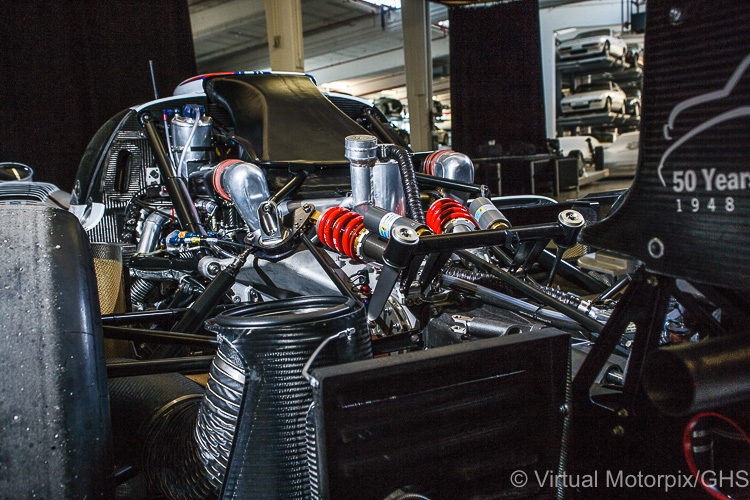
Although this engine could produce a much higher output, and indeed up to 750bhp was achieved on the dyno, it was fabricated to meet the output as dictated by the air restrictors. Breathing through two 33.9mm restrictors, this would allow the engine to generate only 550bhp, and so the engine was prepared with this output in mind.
The 911 GT1/98 featured an in-house designed and constructed six-speed sequential gearbox.
Development & Roll Out
When the project commenced in 1997, Porsche took the unusual step of hiring a Dutch freelance racing car designer. Harm Lagaaij explains, “Wiet Huidekoper, was hired in as an experienced racing car designer because of his previous involvement in Lola cars. He worked together with the engineers of the motorsport department, and obviously, Porsche don’t mention him that often, but he was extremely important for the development of the 1998 car.”
Bob Wollek was the driver entrusted with the roll out of the first GT1/98 (chassis #001) on 23 February 1998 at Weissach. Tony Hatter recalls the roll out, “I can remember, it was getting dark and it was very cold, it always seemed to be cold and miserable here when these things happened. We were at the entrance to the test track and the car was sent off into the dusk. They had set up floodlights and when the car came back, it stopped and I saw a haze coming off the car and the parts were creaking.”

Hatter described the scene as like watching a Steven Spielberg science-fiction film, with the headlights shining through the mist, the steam coming off the bodywork, it was just surreal. When the car returned, the mechanics opened the door and chatted briefly with the driver, and then they closed the door and sent him off again.
“The next time he came past, he was at full power down the straight, it was absolutely unbelievable. This thing worked straight out of the box,” he added.
Harm Lagaaij put it this way, “It drove so nicely, it was so intoxicating to drive that car. It was 1998 state-of-the-art racing technology and of course, the faster you went, the more downforce you had, which is the intoxicating part because the more courage you had to take corners at higher speeds, the reward was that you got more downforce. This is why I liked the GT1/98 so much.”
When pressed on what he meant by ‘intoxicating’, Lagaaij replied, “It was modern technology, it was 1998 state-of-the-art racing technology, the seating position, the pedals, the steering wheel, the gear change, the monocoque, front suspension, cooling and the aerodynamics, were worlds apart. The gear change was completely different, it was sequential, and the ‘96 and ‘97 cars had a conventional gear linkage. The 1998 car had a huge gear lever which you just pushed backwards or forwards.” While the 1997 car was an evolution of the 1996 car, and was therefore very similar in terms of technology, the GT1/98 represented a generational change.
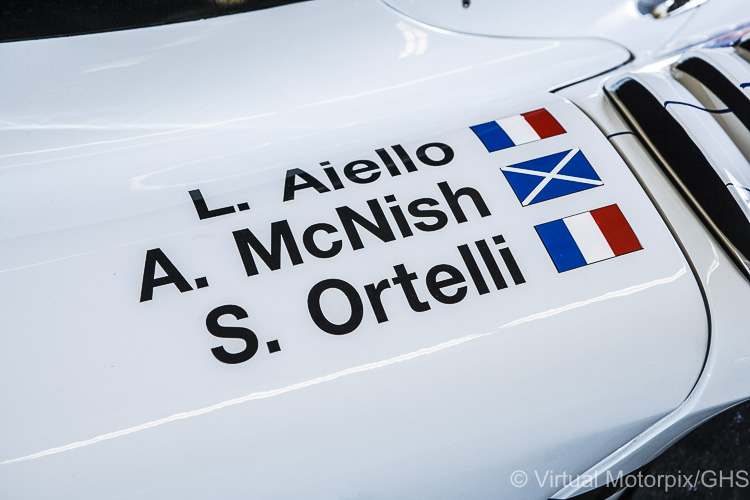
Porsche enjoyed a close association with its main sponsor, Mobil 1, and the dark blue, red and white colours making up the livery on the works cars was very much inspired by those colours. “There is a wonderful German word for it, Kriegsbemalung, which means war paint, which is so wonderful because it really says what it is,” Lagaaij pointed out.
The process of deciding on the livery and what the car will look like externally, is quite a complex process. “What happens on a project like this or any racing car project, is that I need to know as the chief designer, which sponsor companies are involved. I needed to know how much they were paying, how much their percentage in the budget was, and how important the visual appearance was, especially on television. You have one or two big sponsors and then you have the smaller sponsors, and then we go from there. I would look at the proposals submitted and then decide which one of the design proposals was going to be taken,” Lagaaij expanded.
1998 Le Mans 24 Hours – Allan McNish
The Le Mans 24 Hour race was the trophy that Porsche was after, and victory in 1998 would give the company its sixteenth title. Apart from that goal, there was the small matter of the company’s fiftieth birthday, the day after the race.

Scotsman, Allan McNish, was one of the drivers of the #26 Porsche GT1/98 at Le Mans. “When we arrived at Le Mans, it was just like arriving at another part of the factory. Yes, it was in France, but for them it might just as well have been on the other side of Weissach. They were very much at home there, and all the guys seemed to sit down in the same place where they had sat for the previous fifteen years. It was also very clear that they had a passion about it too, because it wasn’t just a marketing exercise. It was an attitude that was embedded in the company.”
One of the homologation requirements for the GT1/98 was that Porsche had to make just one road legal model of this car. In an effort to drive this point home, Porsche’s management insisted that their road car be driven to scrutineering in the centre of Le Mans. The car’s designer, Tony Hatter recalls, “I drove with Bob Wollek in the ‘98 car from the track at Le Mans to scrutineering in the town centre. That was just absolutely incredible, at every set of traffic lights we would have to open the doors because it was so hot inside. I will never forget that because Bob died shortly afterwards, he was such a nice guy.”

Although a Porsche contracted driver in 1996 and 1997, in an attempt to build his endurance racing experience, McNish was loaned out to Roock Racing in America. McNish outlines the difference between driving for a privateer and a works team, “From one year to the next you see a massive difference between a privateer team that is trying to make their way in racing and a factory team who know exactly what they are doing. And that was something that I found with Porsche, where the depth of experience and knowledge of what is required, made it a lot easier for us drivers because we didn’t have to think about that. We would just arrive and drive, because they were the ones who were 95 per cent in control of the car before we even got to the track, and the last five per cent was tuning.

“There was a massive difference in terms of experience, capability and technology. One had the capability to have good results in some races some of the time, but the Porsche factory team had the capability to have good results all of the time. We had all the appropriate physios and dieticians, and we had the areas to rest, and that was not an optional extra, it was a standard.”
McNish’s first taste of the GT1 was in 1997, but his race was not a long one, in fact just eight laps. “I hit the wall in ’97 [at Le Mans] and so the car was out early. It was a lesson for me in terms of getting the car back to the pits, that’s for sure, because it was the first time I had done any long races like that. This happened in the Porsche Curves, they thought it could have been a damper failure. But basically, you get the car back to the pits, no matter what! That was a good bit of Le Mans education for me that I hadn’t thought about at that time. By the following year, I had done a lot more races. [The ’98 car] was a completely different package, you just can’t compare the two of them really,” McNish admitted.

Importantly, the GT1/98 was stable in high-speed corners which was key at Le Mans, but according to McNish, it had ‘a little bit too much understeer’. McNish again, “When it rained in the middle of the night, when it was pretty slippery, that’s when you needed that stability. The big thing was though, that we weren’t so quick in a straight line.”
There was tremendous pressure on the three drivers, Allan McNish/Stéphane Ortelli/Laurent Aïello, to deliver a Le Mans victory for Porsche in 1998. The pressure was two-fold: firstly, the race finished on the eve of Porsche’s 50th anniversary, and secondly, Porsche’s new GT1/98 race car had been beaten in the two rounds of the FIA GT Championships that preceded Le Mans that year.

McNish outlined the pressure on the team, “There was a tremendous amount of pressure because the day we won Le Mans was almost 50 years to the day of the birth of Porsche. The board were there, and everybody expected a victory. Herbert Ampferer was the boss, and against a lot of people’s opinion, he put his trust in three young guys who had nothing in terms of a record at Le Mans. The other thing is that we had been beaten in the races up until then by Mercedes. And so, there was this expectation, because they had built a new car. But we hadn’t succeeded as yet. But then we succeeded with the big one, Le Mans! The company’s actual birthday was on the Monday morning after the race, so we basically celebrated on the Sunday night right through into the Monday morning.”
Tony Hatter, the car’s designer, spent eight days at Le Mans in 1998, but it wasn’t what he expected. He recalled, “There you are with all the team clothing on, but when the flag dropped, I had to remove my team clothing and put on civvies. I spent the whole 24 hours in the pits as a spy with a video! I was assigned to the Panoz and Nissan teams, and I had to check when they refuelled, changed drivers and tyres and radio back to the pits what was going on. And the longer you stood in the pits, the more you would see other people who didn’t apparently have anything to do, because you could see that everybody was watching everybody else, very closely.”
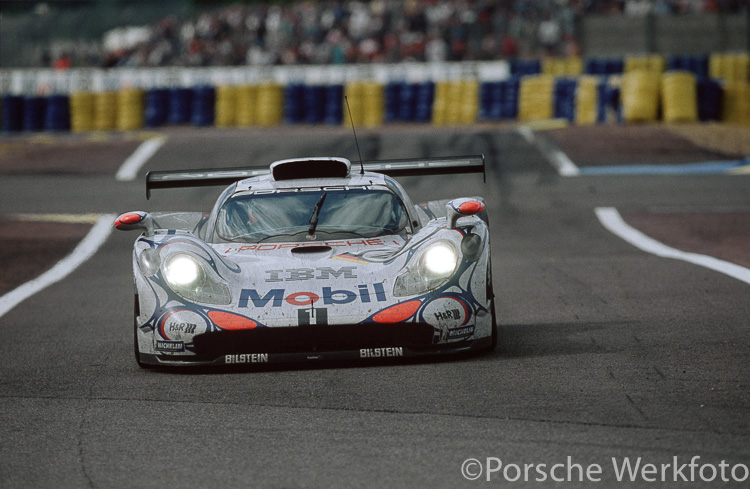
A final word from Allan McNish, “I liked the ‘98 car more than the ‘96 and ‘97 version. It was more of a racing car, I could throw it around, it had better downforce and less shudder, it was just more aggressive. For me it was a good step forward and at Le Mans with the variety of conditions that you get at there, that was its natural environment. We thought that it lacked a bit of straight line speed although it had masses of power, but we had big restrictors in those days in comparison to now, so it got up and went. Everything was where it should be, you weren’t sitting there thinking where is this or that, it was all exactly where it should be. At the end of the day, it was built by people who had been brought up in the racing world and they breathed racing.”

Selected 1998 results – GT1/98 (chassis #003)
| Date | Event | Drivers | Result |
| 28 March | Weissach roll out | n/a | |
| 9 April | Test in Oschersleben | n/a | |
| 12 April | Oschersleben 500 km | McNish/Dalmas | 15th |
| 3 May | Test at Le Mans | McNish/Ortelli/Aïello | n/a |
| 17 May | Silverstone 500km | McNish/Wollek | DNF |
| 16/17 June | Le Mans 24 Hours | McNish/Ortelli/Aïello | 1st (16th win) |
| 12 July | Dijon 500 km | McNish/Dalmas | 2nd |
| 19 July | Hungaroring 500 km | McNish/Dalmas | 3rd |
| 23 August | Suzuka 1000 km | McNish/Dalmas/Ortelli | 3rd |
| 6 September | Donington 500 km | McNish/Dalmas | 3rd |
| 20 September | A1 Ring 500 km | McNish/Dalmas | 3rd |
| 18 October | Homestead 500 km (USA) | McNish/Dalmas | 3rd |
Final word
Chassis WP0ZZZ9RZXS100003 only won one race, that being the 1998 Le Mans 24 Hours. The rest of the season saw this car notch up a single second place in the FIA GT Championships that year, followed by five straight third place finishes.
It is hard to imagine that this race car, certainly one of Porsche’s most graceful looking race winners, could have pounded the tarmac of La Sarthe with such purpose and efficiency, and beat the best that the motor racing world could throw at it. The car is today a proud member of the company’s Museum Collection and it can also be seen out and about at events where it carries out demonstration runs.

The #26 Porsche GT1/98 has been beautifully restored and was made available to the author in May 2017 on a trip to Stuttgart to photograph no less than eight significant road cars and Le Mans winners. This particular car was photographed at Porsche’s secret warehouse near the Museum where, an analogy with a kid’s first trip to the toy store, would not be misleading. The car is outrageous, but at the same time clinical and efficient – the memory will linger for many years!
GT1/98 race car specifications – chassis #003
| Engine | |
| Type | 6-cylinder boxer, aluminium cylinder block & heads |
| Capacity | 3.2-litre (3198cc) |
| Bore x stroke | 95.5 x 74.4mm |
| Power output | ca. 550bhp (365kW) @ 7200rpm |
| Torque | 630Nm @ 5000rpm |
| Compression ratio | 9.0:1 |
| Cooling | water-cooled |
| Valves | 2x intake and 2x exhaust per cylinder |
| Turbocharging | 2x exhaust KKK K27.2 turbochargers with 33.9mm restrictors |
| Intercoolers | 2x charge air intercoolers |
| Lubrication | dry sump |
| Engine management | electronic TAG 3.8 |
| Fuel injection | multipoint sequential |
| Transmission | |
| Type | 6-speed, dog-clutch engagement |
| Gear change | sequential |
| Drive | rear-wheel drive |
| Clutch | triple disc carbon fibre clutch |
| Lubrication | additional lubrication with oil pump, oil-to-water heat exchanger |
| Differential | self-locking diff |
| Suspension | |
| Front | double wishbones with pushrod |
| Rear | double wishbones with pushrod |
| Shock absorbers | additional Bilstein shock absorbers front & rear |
| Steering | power assisted |
| Anti-roll bar | front and rear |
| Wheels & tyres | |
| Wheel rims | 1-part BBS racing rims with central mounting |
| Rims – front | works – 11.5 x 19 ET49 (customers – 11.5 x 18 ET49) |
| Rims – rear | works – 13 x 19 ET66 (customers – 13 x 18 ET66) |
| Tyres – front | works – 27/67-19 Michelin (customers – Michelin 27/65-18) |
| Tyres – rear | works – 31/70-19 Michelin (customers – Michelin 30/70-18) |
| Brakes | |
| System | brake balance adjustable by driver |
| Discs | carbon discs front: 380 x 37mm & rear: 380 x 37mm |
| Callipers – front | 6 pistons (fixed) (Le Mans: 8 pistons (fixed)) |
| Callipers – rear | 6 pistons (fixed) |
| ABS | Bosch ABS |
| Bodywork | |
| Chassis | carbon fibre monocoque |
| Rear wing | adjustable |
| Roll cage | as supporting chassis member |
| Side windows | plastic |
| Air jacks | |
| Fuel tank | 100-litre FT3 safety tank |
| Dimensions | |
| Wheelbase | 2690mm |
| Length | 4890mm |
| Width | 1990mm |
| Height | 1140mm |
| Overall length | 4925mm |
| Weight | ca. 950kg |
Written by: Glen Smale
Images by: Virtual Motorpix/Glen Smale & Porsche


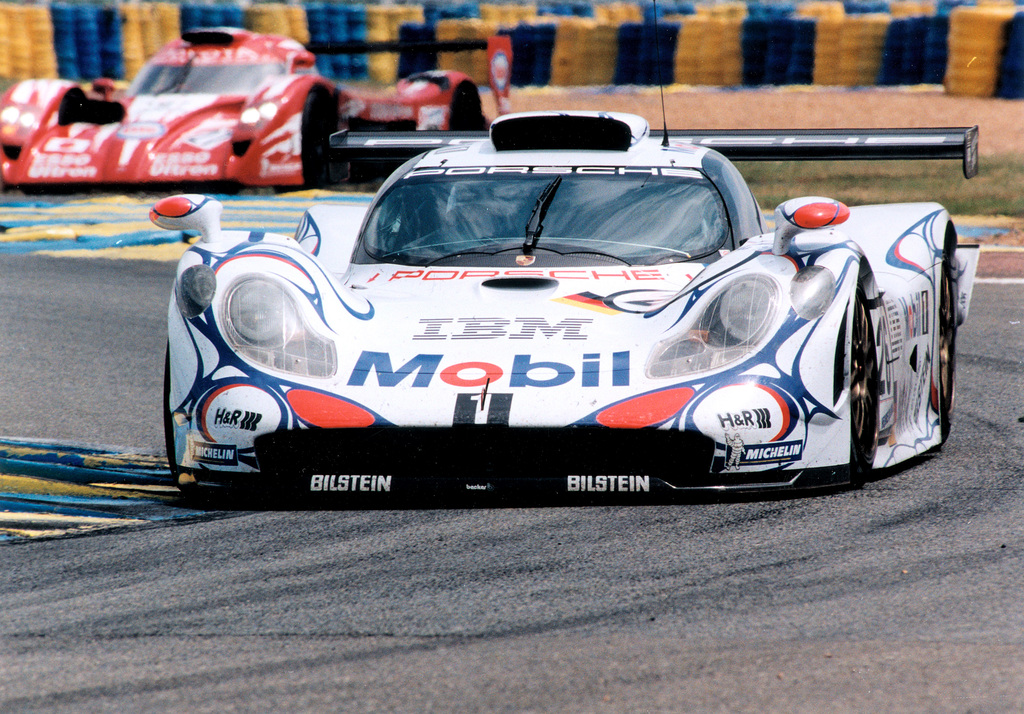

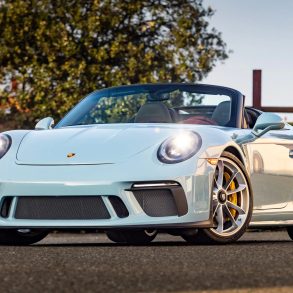





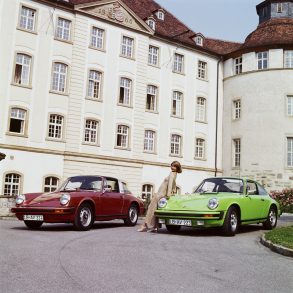
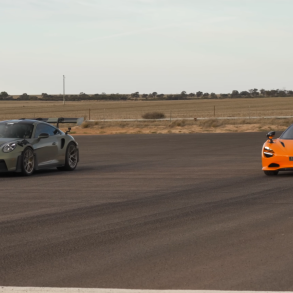

Excellent. Learned a lot from this article. I raced on a team at Le Mans in both 1997 and 1998 with a Ferrari 333sp, against these cars. So I had seen them race, now I know more about them !
0
How can I download these pictures in a high resolution? I’d like to make them just as a personal collection. It’s my absolute favourite race car
0
Hello Ray, Thank you for your interest in the images contained in this feature. I am pleased too that you enjoyed the feature, it was truly an awesome accomplishment by the factory. In response to your request for high resolution copies of the images, I must say that this is not possible. Firstly, the copyright of those images supplied by the Porsche Museum is theirs and it is not for me to distribute this to all who request it. The copyright of those images that have been taken in the Porsche Museum is owned by the photo agency Virtual Motorpix. Should you wish to purchase copies of these, they are available at £30.00 each, and will be subject to a contract restricting their use to just personal use on your own computer. Rgds, The Editor.
0
what does “NRF” mean ? never heard this term in relation to racing stats
0
Hi there, NRF means “Not Running at Finish”. Thanks for reading and commenting. Much appreciated.
0